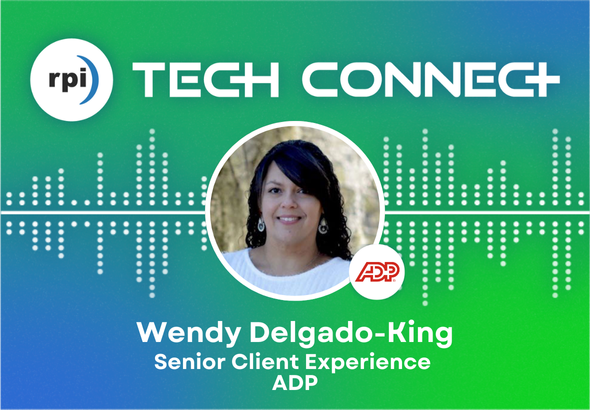Dive into the world of training with RPI Tech Connect. Join host Chris Arey and RPI’s Principal Technical Consultant Jeremy Stoltzfus as they explore the role of hands-on learning in today’s rapidly evolving tech landscape. Discover firsthand accounts of organizations struggling without proper training, and the business improvements they experienced as a result of subsequent coaching.
From Bootcamps to virtual workshops and user groups, find out why staying ahead of the curve is more crucial than ever. Don’t miss out—tune in to find out how training can help your teams tap into their full potential.
Interested in listening to this episode on another streaming platform? Check out our directories.
Meet Today’s Guest, Jeremy Stoltzfus
Jeremy Stoltzfus is a Principal Technical Consultant who has been with RPI since January of 2017. Jeremy is a Certified Infor Developer with technology expertise on both Windows/MS-SQL and Unix/Oracle on-premises and Cloud platforms.
Jeremy’s focus on process improvement within multiple Infor CloudSuite configurations, security, development, upgrade, and data conversion projects has helped Infor clients make the most of their technology investment. He ensures that a client’s business requirements can be achieved in the Infor CloudSuite solutions.
Throughout his career with RPI, Jeremy has worked as a technical consultant, integration architect, systems analyst, programmer, and technical lead for various implementation and optimization projects. Jeremy is also very involved with RPI’s training initiatives and enjoys teaching multi-day workshops and presenting webinars and at Infor user groups.
Prior to joining RPI, Jeremy worked as an Infor Lawson system administrator for 15 years where he led significant upgrade and development efforts. He has always been an active participant in the Infor Lawson community.
Meet Your Host, Chris Arey
Chris Arey is a B2B marketing professional with nearly a decade of experience working in content creation, copywriting, SEO, website architecture, corporate branding, and social media. Beginning his career as an analyst before making a lateral move into marketing, he combines analytical thinking with creative flair—two fundamental qualities required in marketing.
With a Bachelor’s degree in English and certifications from the Digital Marketing Institute and HubSpot, Chris has spearheaded impactful content marketing initiatives, participated in corporate re-branding efforts, and collaborated with celebrity influencers. He has also worked with award-winning PR professionals to create unique, compelling campaigns that drove brand recognition and revenue growth for his previous employers.
Chris’ versatility is highlighted by his experience working across different industries, including HR, Tech, SaaS, and Consulting.
About RPI Tech Connect
RPI Tech Connect is the go-to podcast for catching up on the dynamic world of Enterprise Resource Planning (ERP). Join us as we discuss the future of ERPs, covering everything from best practices and organizational change to seamless cloud migration and optimizing applications. Plus, we’ll share predictions and insights of what to expect in the future world of ERPs.
RPI Tech Connect delivers relevant, valuable information in a digestible format. Through candid, genuine conversations and stories from the world of consulting, we aim to provide actionable steps to help you elevate your organization’s ERP. Whether you’re a seasoned professional or new to the ERP scene, our podcast ensures you’re well-equipped for success.
Tune in as we explore tips and tricks in the field of ERP consulting each week and subscribe to RPI Tech Connect below.
Transcript
Chris (00:02)
Today we’re going to discuss the crucial role of training, whether it’s hands-on, virtual, or a combination of the two. Certain training styles are more suited to specific contexts. Join us as we explore examples of how training enhances individual skill and comfort with system navigation.
Chris (00:03)
Welcome back. This is RPI Tech Connect and I’m your host Chris Airy. Today we’re joined by the technical wizard, Jeremy Stoltzfus. Jeremy is a principal technical consultant at RPI. With over 20 years of experience in the Watson Infor Community, he’s got a solution for every problem your EOP throws your way. Jeremy, is there anything else you want to share?
Jeremy (00:25)
Sure, thanks Chris. As Chris stated, my name is Jeremy Stoltzfus. I have been with RPI for a little, almost seven years now. And in that time, I’ve been working on various projects and upgrades and cloud suite implementations. My background, I’ve come from Lawson System Administrator for many years and worked at a hospital, a healthcare system for about 10 years and another private company as Lawson System Administrator prior to that.
With RPI, I work a lot doing, like I said, Cloud Suite implementations, a lot of focus on solutioning, process improvement, and another part of my RPI experience is I do a lot of training. So whether that’s project training or the various boot camp training classes that we here offer at RPI.
Chris (01:14)
Awesome, Jeremy. I’m glad to have you on the show today and appreciate that you actually mentioned a bootcamp experience because the meat of today’s episode is gonna be on training. I think with technology changing and AI becoming more prevalent, and ERP vendors like in for rolling out new functionality, it’s more important than ever, I think, for employees to kind of stay up to speed on systems.
Jeremy (01:42)
Yeah, absolutely. I mean, what’s interesting is that we’ve got a lot of folks that are on the customer side that have resources, tech resources on their team to support their ERP system. And as the technology changes, especially when you move into a cloud suite environment, the technology has changed drastically from customers that are used to an on-premise installation. So there’s a new toolset and a constantly evolving toolset.
that those people need to stay up to speed on to do their jobs.
Chris (02:16)
It sounds like there’s more resources now than I think ever before for kind of like staying up to speed, whether that’s like YouTube videos or LinkedIn trainings or virtual sessions. And then obviously there’s the hands-on stuff that happens in person. But I imagine not every training is made the same. And some folks are going to, I guess, absorb more information in different environments than others.
Would you, would you agree with that?
Jeremy (02:48)
Yeah, absolutely. I mean, you talk about different training forums or delivery mechanisms for training. Yeah. You’ve got some YouTube videos or some, some shorts that walk through very specific examples and you can learn very quickly, you know, I myself find when I’m trying to uncover something or discover something new or pick up a new skill, I will try to find that a short.
training video or a script or an example of something that I can walk through and do. And it gives me that very focused knowledge. But when you’re talking about a bigger picture, a larger tool set that requires a lot of digging into, an online training video is not necessarily the best approach for something.
Chris (03:36)
Yeah. And you know, you, as a, as a bootcamp instructor, I’m sure that you see just like the kind of impact that hands on training in person in a new environment actually has on, you know, attendees and folks who are trying to like, you know, improve their functional skills. So, so I’m curious though, uh, with that background, how do you, how do you see these skills evolve in the, in the three day time span that they’re at a bootcamp?
Jeremy (04:06)
Yeah. So right. Yeah. So at a bootcamp, obviously when we’re doing those and any in-person training, really, you know, it’s a very different mindset. You’re, you’re typically a hundred percent focused, right. On the topic. There’s an instructor who’s making eye contact with you and you’re making eye contact with them and you’re trying to learn, you know, when I teach bootcamps, I can tell who’s not paying attention and who is right. Just by, just by looking around the room.
Chris (04:07)
That looked right.
Jeremy (04:36)
When I’m teaching a web class or a webinar or something like that, I have no idea who’s actually paying attention if anybody’s actually listening. So you do definitely pick up and you, as an attendee, you typically are more focused and you’re able to pick up and absorb more information because of that.
Chris (04:59)
to ask when you can tell someone’s not paying attention in the classroom, do you call on them? Is it like high school all over again?
Jeremy (05:07)
No, I don’t specifically call them out, but what I do try to do is maybe just start asking the class as a whole some questions to try to facilitate participation. Just to make sure that people are getting engaged.
Chris (05:22)
Participation, yeah. Nice.
Nice. I think that’s actually a big part of what separates, uh, you know, the in-person training sessions versus something online is that you’re you, there’s an opportunity for, for more engagement, right? If you can tell someone to maybe tune it out, you can, you can change your approach and try to, you know, get some response out of people by asking those questions.
Jeremy (05:41)
Yeah.
Absolutely. And even, you know, as you’re walking through hands on exercises, right? That you might be teaching in the class. So, you know, when we do boot camps, we will teach a particular topic. We’ll kind of walk through it on screen as a class, you know, present it. And then we’ll give an exercise for some, for each participant to walk through and get their own hands on it and touch it and, and repeat that exercise. And.
You know, it gives us as instructors the opportunity to kind of walk around and try to help those people that might need a little bit more assistance. And then you have other people that kind of do things and might not do it exactly the way that you, that I as an instructor think that it should be done. And that’s okay because there’s other ways of doing the same thing. And when that type of thing happens, everybody in the class about.
gets value from that, even including myself as an instructor.
Chris (06:49)
Nice. I imagine with this approach, it’s, uh, you’re trying to get folks to think about how they’re going to apply like these learnings from the classroom in their own environments. Is that right?
Jeremy (06:59)
Yeah, absolutely. For example, I taught a configuration console bootcamp a couple of weeks ago. And as I’m going through various topics, I’m watching a couple of people in front of me that their wheels are kind of turning. And I could tell the one woman, she had a question or she had a thought kind of churning in her mind. And that’s exactly what she was doing. She’s like, wait, I think this is going to solve a problem that I have back at my job.
And we talked through it and it gave me an opportunity to kind of express, okay, well, here’s how I would approach that. And yes, you’re right. This is, this is how you would do that. So it gave her some validation and they gave her, um, I think some, some confidence to be able to take those skills from the class and apply them in real life.
Chris (07:47)
It’s got to be a cool feeling to see like the immediate impact you’re having on these folks in these trainings, right? It’s like you just, the story you just told here, you know, like you can see that no matter what, if nothing else, when this attendee leaves and goes back to work, they, what they learned from you is automatically going to have a benefit in their company. Awesome. Love it. Love to hear it. So with that though, like
Jeremy (08:09)
Absolutely. Yep.
Chris (08:17)
Between when an attendee shows up on day one and by the time they leave, do you feel like is it like an expedited college course and you send them on their way and they get their certifications and they feel like they’re pros in the application or what, how would you describe that? If you
Jeremy (08:37)
Yeah, I mean, I think if anything, it boosts confidence, right? So like, I don’t in three days, there is so much that can be done with configuration console that it’s hard to pack it all into three days, right? And that’s just one topic that we teach, right? And so for that particular example, I can I can only do so much and I can give certain examples. But to give the that to just watch that transformation of the participant.
Chris (08:58)
Yeah.
Jeremy (09:07)
learning and being able to adapt. And, you know, I tried to do similar exercises and repeat things to kind of help them get the concepts and you can just watch them progress over those three days.
Chris (09:21)
Nice. And well, you raise a good point there because you can only do so much in three working days, right? And that begs the question, is like how often should folks be training? And on what occasions? On what kind of regular basis? Or when’s a good time to institute training? There’s some questions I have there about the frequency and the situations where training is ideal.
Jeremy (09:50)
Yeah, absolutely. I mean, obviously when you’re doing these Cloud Suite implementation projects during implementation, there’s going to be several periods of training, right? Different topics that need to be covered throughout the project. When I approach a training for a specific project, I try to train when it’s going to be used by the customer. So I don’t train on the development tool at the very beginning of a project if they’re not going to use that tool and use that knowledge for another four months.
Right? So that kind of just helps to align the project goals with the training goals and keeps it keeps it moving and being able to apply what you’ve learned in the training immediately is critical. But then ongoing, you know, as you, you know, as you become live, as you’re taken live, you’re now live on CloudSuite. Right. You’re utilizing these things.
you can become kind of stagnant, especially with the technology that’s changing as quickly as it does within the Cloud Suite environment. You have to stay up on top of the new features coming out and all of the new technologies and how the tools are evolving and changing. But then even going in, you know, so you’re live for a couple years and maybe one of your key resources leaves, right? And they’re replaced. Well, they might not have had…
that background with the implementation to get the in-depth training that is required to continue to be able to support that system. So ongoing as new employees are hired into a customer site, right? That’s when training needs to be repeated for the benefit of those new people that might not have been part of the original implementation.
Chris (11:37)
Sure. There’s two things that I want to unpack. And the first was this, you know, the timeliness of the training. It’s I feel like it’s more often than not if you learn a new skill or you learn how to do something new, if you’re not immediately putting that into practice, you’re going to lose it. You know, it’s like if you don’t use it, you lose it type thing like and if in training, I guess is no different. If you’re going to learn something and you’re not going to use it in any time in the near future.
then you’re probably not going to remember it when it is time to do like, you know, apply that, right. And then, and the other part of that you mentioned is this, is changing in staff. And so it sounds like what you’re saying is that when, when there’s a change in staff, it’s a great time for retraining because the new folks coming in may not have had that exposure during the implementation, or there might be some nuance within the system that they’re just not familiar with. Is that right?
Jeremy (12:11)
Exactly.
Thank you.
Yeah, exactly. And I’ve seen it happen, the evolution of the Lawson product into the Infort Cloud Suite now. I’ve seen customers that have been live on Lawson for 20 years or more. And the people that are running the system today aren’t the people that were there usually during implementation. And it becomes a…
a whisper down the lane type of thing, right? Where you have the original people that trained the next group of people that came in that were working and doing the job and then something gets lost in translation, right? And then the next group of people kind of come in and take over and it gets lost in translation. And so you lose that depth of knowledge just naturally over time.
Chris (13:23)
It’s like the telephone game, right? Where each time someone comes in, that’s like a fragmented portion of how it was supposed to be done. It’s just trickled on over time, right?
Jeremy (13:26)
Yeah, exactly.
Exactly.
Chris (13:38)
Oh man. Okay. So, so cool. And the training here, you know, you think about the impact that training is having on, on attendees and that’s, you know, it’s helping them do their jobs better, but it’s also helping with like career development too. Right. And you got to think that if a sending somebody into a training session where they have three days of hands-on training and they’re learning how to like,
really optimized use of a particular application, it’s making them feel more confident in their own ability and then they’re taking those learnings back to their organization, and then they’re doing their jobs better. And it’s just like all these really great benefits that are happening. And you would think that the organization spending the time to invest in like, you know, future development and skills like that, it’s gotta be a good retention tool. Would you?
Jeremy (14:34)
Yeah, absolutely. Yeah, I mean, I look back on when, not only a retention tool, but also very cost effective. I look back on my time as a system administrator at the healthcare system that I worked for, right? I didn’t have, you know, we didn’t have a big training budget and I wasn’t taking a lot of training classes. I took a few here and there, but I had to spend time figuring things out on my own, right? And that time…
might have been a couple of weeks or a month or two until I really tried to really understood something that I was trying to apply. And if you take that investment of a three day or whatever hands-on course where you’re able to really dive in, focus, and really get a good understanding of the topics.
you know, I think it’s more cost effective because you’ve got that focus. You’re not stumbling figuring things out.
Chris (15:35)
That reminds me of something I actually talked about with Keith on another episode. But, uh, it’s like, don’t reinvent this wheel. If someone’s figured out how to best like use this solution, leverage the resources. Like, I understand folks are more than capable of like spending the time and learning it themselves and, but like, there are ways to, um, you know, I guess, optimize use with the, with the solution and there are resources to do so. Is that right? Yeah.
Jeremy (16:02)
Absolutely. Yes, absolutely.
Chris (16:05)
Love to hear it. Training is a powerful resource and organizations, they realize that, but when you buy something, it’s like, you don’t know what you don’t know and you’re only gonna get the most, I guess, return on investment in a solution if folks know how to use that system. Yeah. Well, I appreciate you sharing that with us, but before we, we’re getting close to time, but before we wrap up.
Jeremy (16:25)
Correct.
Chris (16:33)
I was wondering if you could tell folks today one thing about training, what would it be?
Jeremy (16:40)
Oh, one sentence, 60 seconds. No, I think off with all of what we talked about today, exploring the different training avenues, whether it’s hands-on, whether it’s an online course, and really try to understand what is the best training delivery mechanism for the topic that I want to uncover.
Chris (16:42)
Yeah, one sentence. 60 seconds starts now.
Jeremy (17:08)
You know, if it’s something that’s going to be a little bit more in depth and a little bit harder to understand, probably in-person training is the best option. If it’s a quick task that should only take a couple of hours, right. Then yeah, you can probably watch an online tutorial for 20 minutes and figure out and get a pretty good understanding of it, very specific topic, right? So that would be, that would be my, uh, I think advice is just really kind of.
Make sure that you’re choosing the best training delivery mechanism for the topics that you’re trying to.
Chris (17:40)
That makes sense depending on the type of support and skill you’re looking to improve. There’s going to be learning situations that are maybe more ideal, right? Yeah, okay. Well, cool, man. Thanks for sharing that with us today and for those tuning in, thanks for listening. Just so happened to have several bootcamp sessions coming up later this year.
Jeremy (17:54)
Absolutely.
Chris (18:07)
And several of them will be led by Jeremy, who joined us today. So if you’re looking to level up your skills and learn from the master himself, don’t be shy. If you have a question about today’s episode or something else in general, feel free to contact us at podcast at rpic.com. Again, that’s podcast at rpic.com. Thanks for tuning in and we’ll see you next time.



